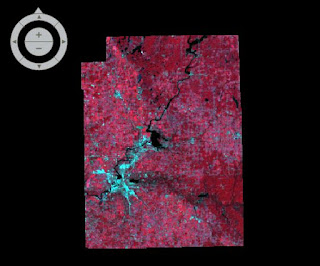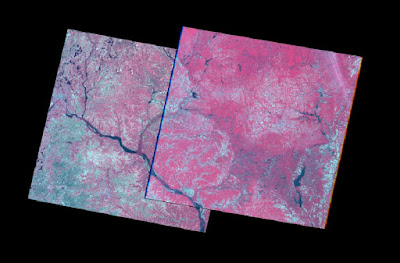Goal and Background:
The goal of this lab is to gain the skills and knowledge
about seven different miscellaneous image functions:
1). Utilizing the Inquire box or delineating an Area of
Interest (AOI) to create an image subset.
2). Optimize the image spatial resolution by creating a
higher spatial resolution image from a coarse resolution image.
3). Introduction to the radiometric enhancement techniques.
4). Familiarizing linking a satellite image to Google Earth.
5). Introduction to resampling techniques.
6). Exploring the process of image mosaicking.
7). Introduction to binary change detection with simple
graphic modeling.
Methods:
ERDAS Imagine was used to complete each of the following
tasks.
1). Image Subsetting of a Study Area:
If the size of the satellite image you are working with is
much larger than your study area or AOI, you can subset the area that you want
so only that specific area is shown in the viewer. One method to create a subset
is by using the Inquire box (Figure 1). With an image already in the viewer, add an Inquire
box on the image. Adjust the size and location so that the Inquire box covers
the AOI. Next, under the Raster tab, select the Subset and Chip tool and go to Create Subset Image. Save the image in the appropriate output folder and make
sure to click From Inquire Box from the Subset widow to ensure the coordinates
of the image will match with the Inquire box. The next method is to create
a subset by using an AOI shape file. With an image already in the viewer, add
the AOI shape file in the same viewer. Then select the shape file so that it is
highlighted. After that, click on the Home button and select paste from
selected object. Dotted lines will appear indicating that an AOI was created
from the shapefile (Figure 2). Lastly, save the AOI as an AOI file, and once again select
Subset and Chip from Raster tools to create the subset image and then save.
 |
| Figure 1: Subset using Inquire Box |
 |
| Figure 2: Dotted lines indicating the AOI was created from the shape file. |
2). Image Fusion:
With the desired images already in the viewers, select the Raster
tools and go to Pan Sharpen and then Resolution Merge (Figure 3). Once the Resolution
Merge window is open, set the methods to Multiplicative and the resampling techniques
to Nearest Neighbor. Lastly, save in the appropriate output folder.
 |
| Figure 3: Both Images Before the Resolution Merge |
3). Simple Radiometric Sampling Techniques:
With the desired image already in the viewer (Figure 4), select Raster
and go to Radiometric and then Haze Reduction. Input the correct image and then
save to the appropriate output folder.
 |
| Figure 4: Image Before Haze Reduction |
4). Linking Image Viewer to Google Earth:
With the desired image already in the viewer (Figure 5), select Connect
to Google Earth. Next, click Match GE to View to have the image viewer and the Google
Earth window be at the same extent. To synchronize both windows, select Sync GE
to View (Figure 6). Google Earth aids as a selective interpretation key.
 |
| Figure 5: Image |
 |
| Figure 6: Google Earth |
5). Resampling:
There will be two sampling techniques in this section. First,
with the desired image already in the viewer, select Raster and go to Spatial
and then Resample Pixel Size. Set the resampling method to Nearest Neighbor and
change the output cell size from 30x30 meters to 15x15 meters. Finally, check
the Square Cells box to ensure that the output pixels will be square. Second,
repeat the same process as previously but set the sampling method to Bilinear
Interpolation.
6). Image Mosaicking:
This image function is useful when the AOI is divided between
two images. There are two different ways to mosaic images together. First, add
two images into the same viewer but make sure that Multiple Images in Virtual Mosaic
is checked before adding them (Figure 7). Next, select Raster and go to Mosaic and then
Mosaic Express. For the second method, add two images in the same viewer, select
Raster and go to Mosaic and then MosaicPro. Once the MosaicPro window is open,
add one of images in and click the Compute Active Area. Then add the second
image in and do the same. Open the Color Corrections window and check the Use
Histogram Matching box and then select the Set button. This will take you to
the Histogram Matching pop up window where the Matching Method will be changed
to Overlap areas.
7). Binary Change Detection:
First, add two viewers and add the desired images, one in
each viewer. Select Raster and go to Functions and then Two Image Functions.
Change the operator from + to -. After the image differencing has ran, bring
the new image into a viewer and view the metadata. The image does not display
the difference but by looking at the histogram, a cut off point can be
determined by using a rule of thumb threshold of mean + (1.5) Standard Deviation.
Model Maker can also be used to show change by completing the same process (Figure 8).
After the Model Maker has run the process, the resulting raster image was opened
in ArcMap to show the change through a map.
 |
| Figure 9: Inquire Box Method |
 |
| Figure 10: AOI Shape File Method |
 |
| Figure 11: Image After Haze Reduction |
 |
| Figure 12: Bilinear Interpolation Technique |
 |
| Figure 13: Nearest Neighbor Technique |
 |
| Figure 14: Result from Mosaic Express |
 |
| Figure 15: Result from MosaicPro |
 |
| Figure:16 Histogram With Cut Off Points |
 |
| Figure 17: Map Representing Changed Areas |

